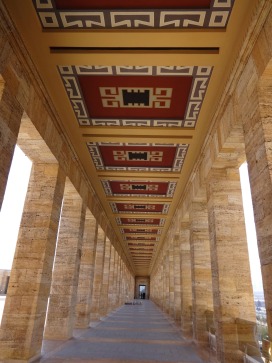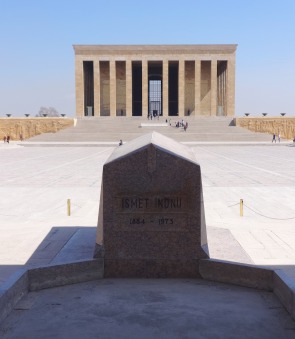The burial place of Mustafa Kemal Atatürk, the first president of Turkey, is known as the Anıtkabir (Monumental Tomb). Not only is it an important site of pilgrimage for all Turks as well as many tourists but it is also the setting for many annual celebrations, particularly on Zafer Bayramı (Victory Day, 30 August), Cumhuriyet Bayramı (Independence Day, 29 October) and the anniversary of Atatürk’s death (10 November).
After Atatürk died in the Dolmabahçe Palace in İstanbul in 1938, his body was brought to Ankara to lie in state in what is now the impressive Ethnography Museum in Opera. Later, it was buried beneath an immense 40-ton cenotaph in a vast memorial site surrounded by memorabilia.
The memorial site was designed by architects Emin Onat and Orhan Arda who won an international competition to come up with ideas for it. It was built in stages between 1944 and 1953.
To come here is to gain some insight into just how important the “Father of the Turks” remains to the country more than 85 years after his death.
The site is open daily from 8.30am to 5pm. Admission is free and visitors are expected to conduct themselves respectfully.
Around the site
Atatürk is buried in a simple tomb inside a vast porticoed hall whose Modernist design will look very Soviet to some. There is nothing else inside the hall, just a fine sweep of polished marble. Golden mosaics decorate the high ceilings harking back to the distant world of Byzantium. 
The tomb is at the top of a flight of steps from a large parade ground ringed with porticoes offering fine views out over Ankara. İsmet İnönü (1884-1973), Turkey’s second president, is buried in a far simpler tomb looking across to his more illustrious predecessor’s last resting place. The square can accommodate up to 15,000 visitors.
The catafalque that carried Atatürk’s body from Dolmabahçe Palace and cars and boats used by him are displayed in rooms incorporated into the portico.
There is also a sizeable museum devoted to Atatürk’s life and to the events of the Turkish War of Independence (1919-22) that runs under the hall containing his tomb. Dioramas complete with sound effects and paintings of individual episodes take up much of the space but there are also many photographs as well as a fairly predictable collection of items that used to belong to Atatürk.
For those interested in the Republic of Turkey’s early history this will be very absorbing; for those less riveted by the details of war it might seem rather overwhelming especially when many groups are visiting at the same time.
The last part of the path to the tomb from the Tandoğan entrance is lined with imitation Hittite lions in pairs, a reminder of Atatürk’s interest in the Hittites as possible proto-Turks. At the start of the path are two small rooms, one containing the catafalque, the other giving details about the men behind its design and about the materials used in building it.
Changing of the guards at the site takes place every hour with a lot of shouted orders and military goose-stepping. Everyone rushes to photograph it which means that these are the best times to nip inside the tomb and escape the crowds.
Tip: There is little shade at Anıtkabir and the sun shining on the marble can be dazzling. Bring a hat and sunglasses.

Transport info
Anıtkabir is within walking distance of Ulus. Alternatively, you can get there via Anadolu/Anıtkabir station on the Ankaray – come out of the exit and turn left, then right up the hill. The entrance to the site is a 5-minute walk from the station but it’ll then take another 20 minutes to walk to the memorial. Free minibuses wait to run people from the entrance to the site.
There’s a taxi rank just outside the entrance.


